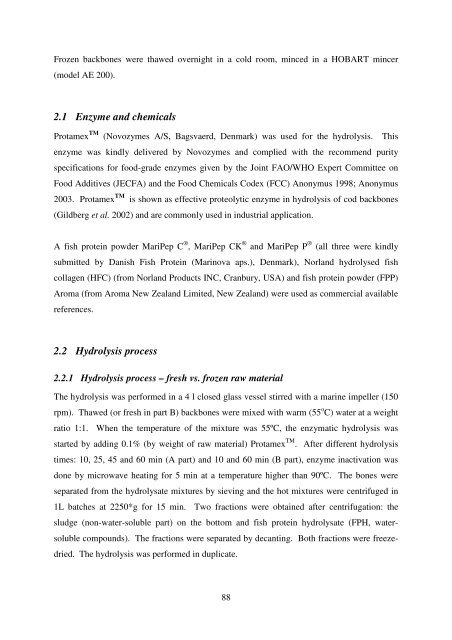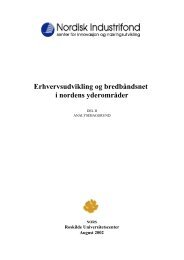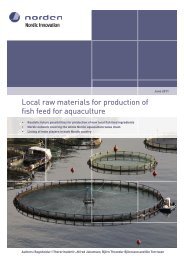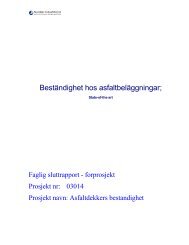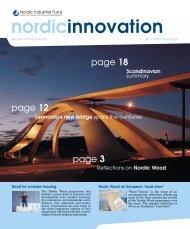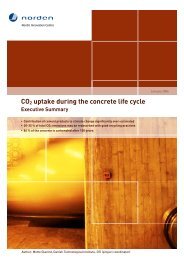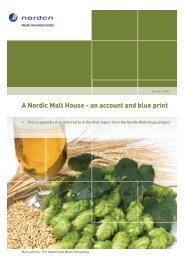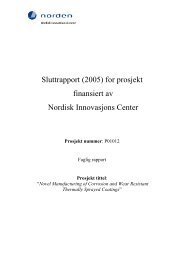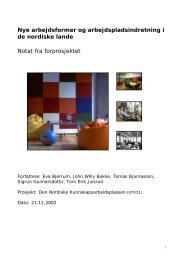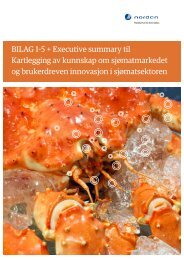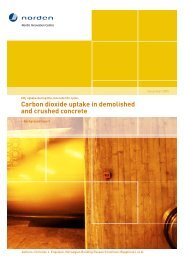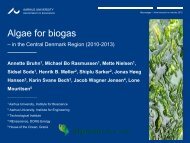Value added fish by-products - Nordic Innovation
Value added fish by-products - Nordic Innovation
Value added fish by-products - Nordic Innovation
Create successful ePaper yourself
Turn your PDF publications into a flip-book with our unique Google optimized e-Paper software.
Frozen backbones were thawed overnight in a cold room, minced in a HOBART mincer<br />
(model AE 200).<br />
2.1 Enzyme and chemicals<br />
Protamex TM (Novozymes A/S, Bagsvaerd, Denmark) was used for the hydrolysis. This<br />
enzyme was kindly delivered <strong>by</strong> Novozymes and complied with the recommend purity<br />
specifications for food-grade enzymes given <strong>by</strong> the Joint FAO/WHO Expert Committee on<br />
Food Additives (JECFA) and the Food Chemicals Codex (FCC) Anonymus 1998; Anonymus<br />
2003. Protamex TM is shown as effective proteolytic enzyme in hydrolysis of cod backbones<br />
(Gildberg et al. 2002) and are commonly used in industrial application.<br />
A <strong>fish</strong> protein powder MariPep C ® , MariPep CK ® and MariPep P ® (all three were kindly<br />
submitted <strong>by</strong> Danish Fish Protein (Marinova aps.), Denmark), Norland hydrolysed <strong>fish</strong><br />
collagen (HFC) (from Norland Products INC, Cranbury, USA) and <strong>fish</strong> protein powder (FPP)<br />
Aroma (from Aroma New Zealand Limited, New Zealand) were used as commercial available<br />
references.<br />
2.2 Hydrolysis process<br />
2.2.1 Hydrolysis process – fresh vs. frozen raw material<br />
The hydrolysis was performed in a 4 l closed glass vessel stirred with a marine impeller (150<br />
rpm). Thawed (or fresh in part B) backbones were mixed with warm (55 o C) water at a weight<br />
ratio 1:1. When the temperature of the mixture was 55ºC, the enzymatic hydrolysis was<br />
started <strong>by</strong> adding 0.1% (<strong>by</strong> weight of raw material) Protamex TM . After different hydrolysis<br />
times: 10, 25, 45 and 60 min (A part) and 10 and 60 min (B part), enzyme inactivation was<br />
done <strong>by</strong> microwave heating for 5 min at a temperature higher than 90ºC. The bones were<br />
separated from the hydrolysate mixtures <strong>by</strong> sieving and the hot mixtures were centrifuged in<br />
1L batches at 2250*g for 15 min. Two fractions were obtained after centrifugation: the<br />
sludge (non-water-soluble part) on the bottom and <strong>fish</strong> protein hydrolysate (FPH, water-<br />
soluble compounds). The fractions were separated <strong>by</strong> decanting. Both fractions were freeze-<br />
dried. The hydrolysis was performed in duplicate.<br />
88


